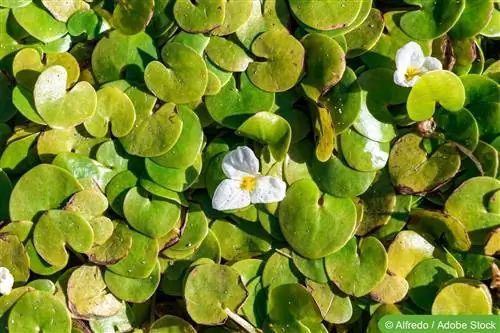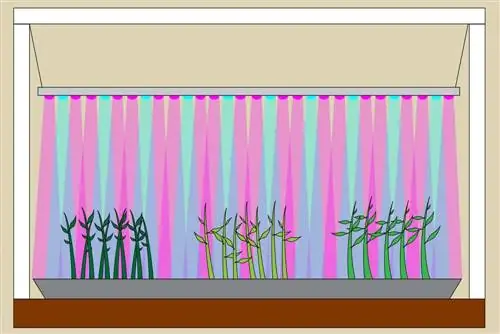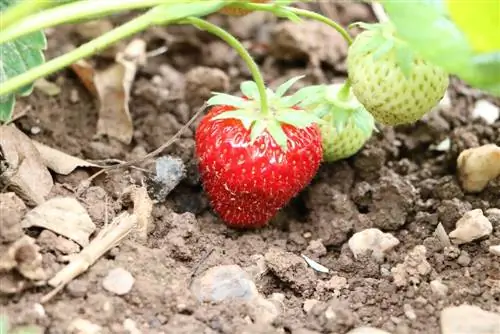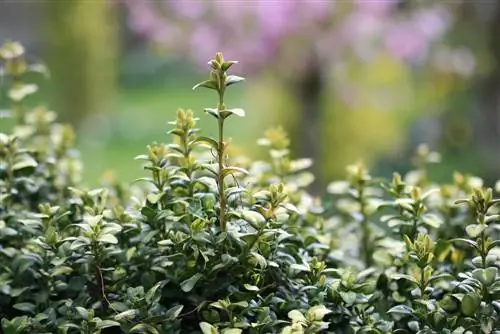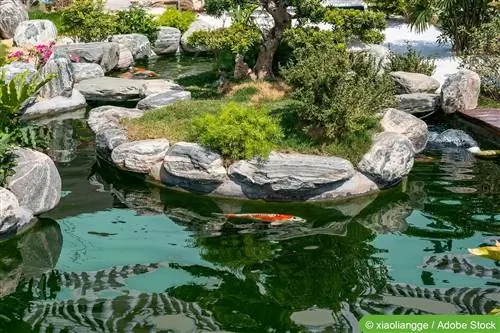- Author admin [email protected].
- Public 2023-12-17 03:39.
- Last modified 2025-01-24 12:45.
Frog bites are often found in garden ponds or aquariums. The plant is used for decorative purposes but also to improve water quality. We give tips on caring for the floating plant.
Easy-care floating plants for the aquarium
The Latin name of South American frogbit is Limnobium laevigatum. It is also commercially available under the name Amazon frog bite. North American frogbit, Limnobium spongia, is less commonly used for aquariums. Frogbit, which is native to Europe, is only available for garden ponds under the botanical name Hydrocharis morsus-ranae, as it does not thrive in the aquarium because the temperatures are usually too high.
The South American frog bite, which can also tolerate tropical water temperatures, is particularly interesting for aquarists. The plant is a floating plant with small, round leaves that form long runners. In addition to the shoots, roots also grow on the plant, but these are not planted in the aquarium floor. Frogbit needs to swim to the surface. Occasionally its roots grow down to the ground and anchor themselves there. The young plants are simply placed on the water and then take care of themselves.
- native frog bite species for the garden pond
- South American frog bite species for the aquarium
- evergreen floating plant
- decorative plants for the aquarium
Good keeping conditions for frog bites
The frog bite for aquarium keeping requires a lot of light. The lighting requirements can be met with appropriate lighting in the aquarium lid. The water should contain nutrients so that the plant grows large leaves. If the humidity is high enough, the round leaves can reach considerable sizes and thus shade the water surface. For some species of fish, this shading is good protection; for other species, care must be taken to ensure that the aquarium does not become too dark. The frog bite thrives better in calm water than right next to a pump or strong water movement. The temperatures can be kept higher as the South American plant copes well with it.
The frog bite spreads via the long runners that form over the water surface. New plants often develop at the ends that can be used for additional aquariums or exchanged with other aquarists. The plant grows in the aquarium all year round and does not take a winter break. It rarely develops flowers when cared for.
Low maintenance required
Froschbite is a real beginner plant that is very easy to care for. Apart from regular thinning and shortening the roots, no other work is necessary. However, the roots should be shortened to a maximum of five centimeters as they represent an ideal hiding place for young fish. When caring for frog bites, the only thing you should pay attention to is good lighting. If the plant spreads too much, it must be trimmed so that it does not crowd out other aquarium plants. The aquarist usually doesn't have to worry about propagation, as the plant tends to spread too much in good conditions.
If propagation is desired, the shoots on which new plants with roots have formed are simply separated. This is easy to do with your hands as the tendrils come off easily. If the frog bite is not thriving, giving CO2 can accelerate growth. Fertilizing with iron in liquid form can also promote leaf formation, but care must be taken to ensure that this does not harm the other aquarium inhabitants.
- good water quality
- avoid hard water
- provide good lighting
- occasional fertilizer applications
- lighten regularly
Frog bite in the garden pond
The same husbandry and care measures apply when caring for the frog bite in the garden pond. South American frogbit is not suitable for the pond because it cannot survive winter temperatures. The European frogbit, on the other hand, is hardy and forms winter buds at low temperatures. It sinks to the bottom of the pond and hibernates there until the next spring. As with aquarium plants, regular thinning with a landing net is urgently needed, otherwise the frog bite can spread too much and shade the water too much. Other pond plants are also displaced if the plant can expand over the entire water surface. In the pond, the frog bite produces white flowers that look very decorative. Like all floating plants, the water should be clean and as soft as possible. The local frog bite cannot tolerate calcareous water.
Frog Bite Care Problems
Froschbite is not very demanding and is therefore very easy to care for. The plant has no pests. The water quality must be taken into account both in the aquarium and in the pond. Regular thinning is the most important care measure to ensure that the pond or aquarium does not become too overgrown. Frog bites hardly cause any problems in garden ponds if the water quality and lighting conditions are optimal. For aquarium plants that tend to thrive poorly, the lighting should be improved and some fertilizer given. The biggest problem when keeping in a pond or aquarium is the sometimes uncontrolled spread of frog bites.
Conclusion: Ideal aquatic plant for beginners
- Frogbit is one of the floating plants for ponds and aquariums that thrives in almost all conditions.
- The maintenance effort is limited. Frog Bite is ideal for beginners.
- The decorative plants can be used to create very beautiful effects with light and shadow, especially in the aquarium, which also benefit the aquarium inhabitants.
- The frog bite is known to cause leaves to look like small lily pads or resemble the shape of a frog's snout.
- The plant usually grows in stagnant water.
- The leaves float on the surface of the water and hang together in large groups as floating leaf carpets.
- The leaf associations only float on the surface of the water during the growing season. Winter buds (turions) form in autumn.
- These detach themselves and sink to the bottom of the water. The remaining sprout parts die.
- The turions overwinter in the ground mud. New plants develop from them in April/May. These rise back to the water surface.
- Since their roots usually do not reach the bottom, the frog bite absorbs its nutrients directly from the water.
- The flowers, which appear from May to August, consist of three white petals and a bract. The base is yellow.
- The flowers rise 15 to 30 cm above the water surface. The leaves are olive green, very shiny and heart-shaped.
- For propagation, you can separate the outer leaf rosettes and place them in a body of water to be repopulated.
- Young plants are simply exposed to the surface of the water from the end of May.
The frogbit is a popular ornamental plant for the garden pond. It harmonizes particularly well with crab claws, swimming ferns and duckweed. The plant is also very popular in aquariums in a miniature version. It filters harmful substances from the water via its roots. The roots also offer good hiding places for young fish and small fish.
Frog bite is on the regional red list of endangered species. It grows best in wind-protected, full sun to shady locations. The water should be warm, rich in nutrients, not excessively polluted and low in lime. The plant prefers stagnant or slow-moving water over muddy ground. The depth of the water is not important. Every now and then the plant that tends to spread too much should be thinned out, otherwise it can deprive the underwater plants of light.

